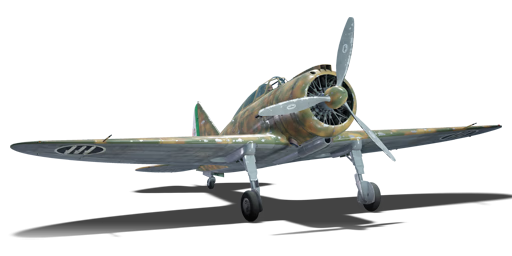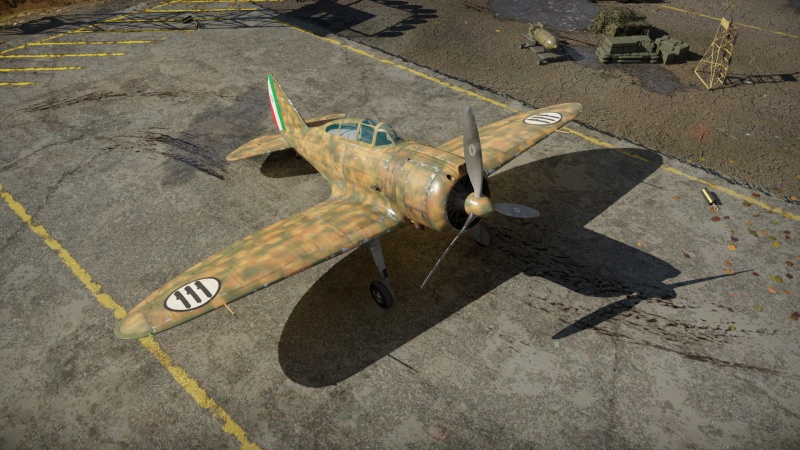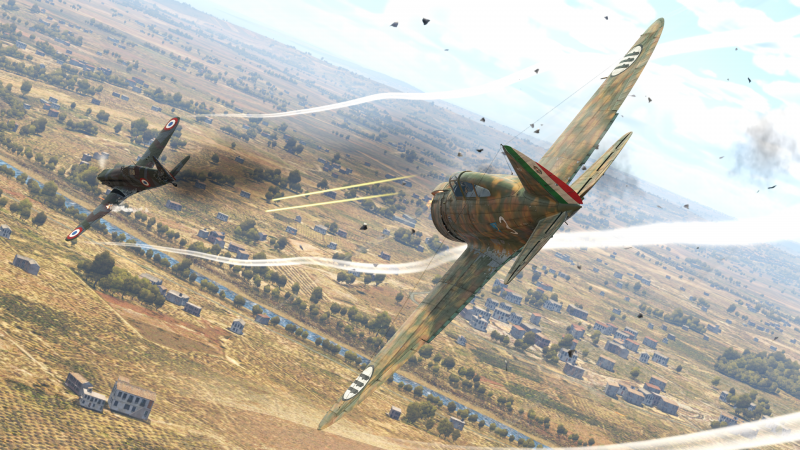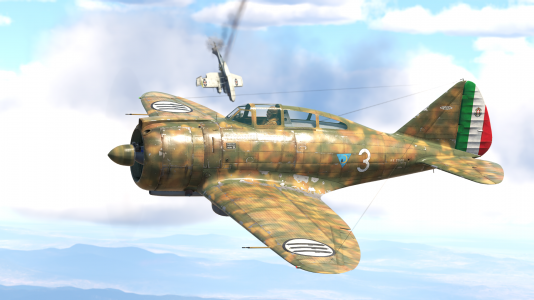Difference between revisions of "Re.2000 serie 1"
Colok76286 (talk | contribs) (Edits) |
(New Specs-Card Artimage. Old picture moved to Media: Images) |
||
| (6 intermediate revisions by 6 users not shown) | |||
| Line 6: | Line 6: | ||
{{Specs-Card | {{Specs-Card | ||
|code=re_2000_int | |code=re_2000_int | ||
| − | |images={{Specs-Card-Image|GarageImage_{{PAGENAME}}.jpg}} | + | |images={{Specs-Card-Image|GarageImage_{{PAGENAME}}.jpg|ArtImage2_{{PAGENAME}}.png}} |
|cockpit=cockpit_re_2000_int.jpg | |cockpit=cockpit_re_2000_int.jpg | ||
}} | }} | ||
| Line 12: | Line 12: | ||
== Description == | == Description == | ||
<!-- ''In the description, the first part should be about the history of and the creation and combat usage of the aircraft, as well as its key features. In the second part, tell the reader about the aircraft in the game. Insert a screenshot of the vehicle, so that if the novice player does not remember the vehicle by name, he will immediately understand what kind of vehicle the article is talking about.'' --> | <!-- ''In the description, the first part should be about the history of and the creation and combat usage of the aircraft, as well as its key features. In the second part, tell the reader about the aircraft in the game. Insert a screenshot of the vehicle, so that if the novice player does not remember the vehicle by name, he will immediately understand what kind of vehicle the article is talking about.'' --> | ||
| − | The | + | The Re.2000 was a monoplane fighter developed in Italy during the mid-1930s. It was one of the first modern fighters used in the Regia Aeronautica. It also served in the Swedish Air Force as the [[J20]], and in the Hungarian Air Force as the MÁVAG Héja I, a modified version of the original model. The design team took inspiration from the American Seversky P-35. The aircraft was considered an outstanding dogfighter, proving superior to the more modern Macchi C.200s and Messerschmitt Bf 109 Es in flight trials. However, the aircraft was not deemed satisfactory by the Italian military, and its manufacturer exported most of the produced units to Hungary and Sweden. The aircraft served as a basis for future models like the [[Re.2001 (Family)|2001]], [[Re.2002 Early|2002]], 2003, 2004 and [[Re.2005 serie 0|2005]] fighters. |
| + | |||
| + | Introduced in [[Update 1.77 "Advancing Storm"]], the Re.2000 serie 1 is a very good dogfighter. For its BR, it has very good acceleration at top speeds and an amazing climb rate, outperforming many early fighters like early Bf 109s. The Re.2000 can be used effectively in both energy fighting and turn fighting. For the former, it's better to have the energy advantage and use the good dive performance of the aircraft to its advantage. To get good positions, it is a good idea to start climbing at the start of the match, to an altitude of around 3,000-4,000 m. The Re.2000 should look out for enemies like the Spitfire and I-16, since these two can outturn you while not sacrificing too much performance in level flight, like biplanes. | ||
== General info == | == General info == | ||
| Line 112: | Line 114: | ||
Some enemies to be concerned about are: | Some enemies to be concerned about are: | ||
| − | * | + | * [[Spitfire (Family)|Spitfire]]: The early versions carrying eight machine guns in their wings and will likely out turn you. |
| − | * P- | + | * [[P-26 (Family)|P-26]]: Especially the version that carries a 12.7 mm M2 Browning machine gun. |
* Any biplane: Most of these are very good turners. They can earn back speed after multiple turns very quickly, so in a dogfight, the Re.2000 might feel sluggish. Don't get baited into these turn fights and instead use the speed/climb to fly away towards an advantageous position to attack. | * Any biplane: Most of these are very good turners. They can earn back speed after multiple turns very quickly, so in a dogfight, the Re.2000 might feel sluggish. Don't get baited into these turn fights and instead use the speed/climb to fly away towards an advantageous position to attack. | ||
| Line 141: | Line 143: | ||
* Great climb rate | * Great climb rate | ||
| − | * Great at energy fighting | + | * Great at energy fighting |
* Good at dogfighting (some enemy aircraft still can destroy you easily) | * Good at dogfighting (some enemy aircraft still can destroy you easily) | ||
* Good turn rate, amazing at 400-500 km/h (248-310 mph) | * Good turn rate, amazing at 400-500 km/h (248-310 mph) | ||
| − | |||
* Very good acceleration | * Very good acceleration | ||
| − | * | + | * Decent high-altitude performance |
| − | |||
| − | |||
| − | |||
* Good energy retention | * Good energy retention | ||
* Good stall speed (below 45 km/h) | * Good stall speed (below 45 km/h) | ||
| Line 155: | Line 153: | ||
'''Cons:''' | '''Cons:''' | ||
| − | |||
| − | |||
* Underwhelming performance of the 2 x 12.7 Breda-SAFAT machine guns | * Underwhelming performance of the 2 x 12.7 Breda-SAFAT machine guns | ||
| − | |||
* Overheats easily, even with 100% radiators, can only WEP for a few seconds before the engine overheats and destroys itself | * Overheats easily, even with 100% radiators, can only WEP for a few seconds before the engine overheats and destroys itself | ||
* Sensitive to battle damage (damage will usually result in the aircraft catching fire) | * Sensitive to battle damage (damage will usually result in the aircraft catching fire) | ||
| Line 167: | Line 162: | ||
<!-- ''Describe the history of the creation and combat usage of the aircraft in more detail than in the introduction. If the historical reference turns out to be too long, take it to a separate article, taking a link to the article about the vehicle and adding a block "/History" (example: <nowiki>https://wiki.warthunder.com/(Vehicle-name)/History</nowiki>) and add a link to it here using the <code>main</code> template. Be sure to reference text and sources by using <code><nowiki><ref></ref></nowiki></code>, as well as adding them at the end of the article with <code><nowiki><references /></nowiki></code>. This section may also include the vehicle's dev blog entry (if applicable) and the in-game encyclopedia description (under <code><nowiki>=== In-game description ===</nowiki></code>, also if applicable).'' --> | <!-- ''Describe the history of the creation and combat usage of the aircraft in more detail than in the introduction. If the historical reference turns out to be too long, take it to a separate article, taking a link to the article about the vehicle and adding a block "/History" (example: <nowiki>https://wiki.warthunder.com/(Vehicle-name)/History</nowiki>) and add a link to it here using the <code>main</code> template. Be sure to reference text and sources by using <code><nowiki><ref></ref></nowiki></code>, as well as adding them at the end of the article with <code><nowiki><references /></nowiki></code>. This section may also include the vehicle's dev blog entry (if applicable) and the in-game encyclopedia description (under <code><nowiki>=== In-game description ===</nowiki></code>, also if applicable).'' --> | ||
| − | The first project of the Reggiane design office was the Re.2000 which was designed by Italian engineers Alessio and Longhi. The first test flight was flown by Mario de Bernardi in 1939. With a superior engine in comparison to the FIAT powered | + | The first project of the Reggiane design office was the Re.2000 which was designed by Italian engineers Alessio and Longhi. The first test flight was flown by Mario de Bernardi in 1939. With a superior engine in comparison to the FIAT-powered M.C.200, it was thought to be at least as manoeuvrable as the Bf 109 E in comparative trials, though the positioning of the fuel tank in an unarmoured wing centre section was found to be a fatal drawback and thus it was not accepted into Italian service, however, the Re.2000 was sold to both Hungary and Sweden to complement their air forces. During 1940, the Italian Navy ordered a modified version for carrier use with a Piaggio P.XI bis engine and structural strengthening for catapult launching and carrier landings.<ref>Thompson, Jonathan W., Italian Civil and Military Aircraft 1930-1945, Aero Publishers, Los Angeles (1963), 304 pages.</ref> |
| − | Hungary bought 70 Re.2000s and built | + | Hungary bought 70 Re.2000s, modifying them into MÁVAG Héja I's, and built 204 MÁVAG Héja II's which were upgraded versions based on the Héja I. Sweden bought 60, where they stayed in service until 1946. Britain had put in an order for 300, as well, before the onset of war prevented it. Those few of the 188 that were built by the Reggiane company that were not sold to other countries were used by an Italian squadron on Sicily in 1941/42, or converted for catapult use. |
== Media == | == Media == | ||
<!-- ''Excellent additions to the article would be video guides, screenshots from the game, and photos.'' --> | <!-- ''Excellent additions to the article would be video guides, screenshots from the game, and photos.'' --> | ||
| + | |||
| + | ;Images | ||
| + | <gallery mode="packed-hover" heights="200"> | ||
| + | File:ArtImage Re.2000 serie 1.png|<small>The Re.2000 serie 1 shot down a PBY-5A Catalina</small> | ||
| + | </gallery> | ||
;Skins | ;Skins | ||
Latest revision as of 22:16, 18 February 2024
| This page is about the Italian fighter Re.2000 serie 1. For the other version, see Re.2000 G.A.. |
Contents
Description
The Re.2000 was a monoplane fighter developed in Italy during the mid-1930s. It was one of the first modern fighters used in the Regia Aeronautica. It also served in the Swedish Air Force as the J20, and in the Hungarian Air Force as the MÁVAG Héja I, a modified version of the original model. The design team took inspiration from the American Seversky P-35. The aircraft was considered an outstanding dogfighter, proving superior to the more modern Macchi C.200s and Messerschmitt Bf 109 Es in flight trials. However, the aircraft was not deemed satisfactory by the Italian military, and its manufacturer exported most of the produced units to Hungary and Sweden. The aircraft served as a basis for future models like the 2001, 2002, 2003, 2004 and 2005 fighters.
Introduced in Update 1.77 "Advancing Storm", the Re.2000 serie 1 is a very good dogfighter. For its BR, it has very good acceleration at top speeds and an amazing climb rate, outperforming many early fighters like early Bf 109s. The Re.2000 can be used effectively in both energy fighting and turn fighting. For the former, it's better to have the energy advantage and use the good dive performance of the aircraft to its advantage. To get good positions, it is a good idea to start climbing at the start of the match, to an altitude of around 3,000-4,000 m. The Re.2000 should look out for enemies like the Spitfire and I-16, since these two can outturn you while not sacrificing too much performance in level flight, like biplanes.
General info
Flight performance
This Italian plane is best used as an energy fighter and can be a very good start to learn how to use Italian planes.
The plane climbs and dives very well, it can reach a high speed quickly, but like every Italian plane in this rank, controls will be stiff above 500 km/h (310 mph) IAS.
The best performance is between 400 to 500 km/h (248 to 310 mph) IAS, but in level flight the max speed is 450 km/h IAS.
To be in the above-mentioned speed range, climb up to 3,000 m, and then dive onto the enemy. If the enemy is more than 2 km below, cut your throttle to 0% and only increase once at the same altitude as the enemy and started to losing speed. Diving or climbing straight at a 90-degree angle will cause the engine to shut down due to fuel cut-off.
| Characteristics | Max Speed (km/h at 5,300 m) |
Max altitude (metres) |
Turn time (seconds) |
Rate of climb (metres/second) |
Take-off run (metres) | |||
|---|---|---|---|---|---|---|---|---|
| AB | RB | AB | RB | AB | RB | |||
| Stock | 510 | 495 | 10000 | 16.8 | 17.3 | 12.8 | 12.8 | 220 |
| Upgraded | 550 | 530 | 15.5 | 16.0 | 20.6 | 16.2 | ||
Details
| Features | ||||
|---|---|---|---|---|
| Combat flaps | Take-off flaps | Landing flaps | Air brakes | Arrestor gear |
| ✓ | ✓ | ✓ | X | X |
| Limits | ||||||
|---|---|---|---|---|---|---|
| Wings (km/h) | Gear (km/h) | Flaps (km/h) | Max Static G | |||
| Combat | Take-off | Landing | + | - | ||
| 740 | 320 | 457 | 428 | 280 | ~13 | ~10 |
| Optimal velocities (km/h) | |||
|---|---|---|---|
| Ailerons | Rudder | Elevators | Radiator |
| < 350 | < 350 | < 380 | > 200 |
Survivability and armour
- No armour plates
- Self-sealing fuel tanks
Modifications and economy
Armaments
Offensive armament
The Re.2000 serie 1 is armed with:
- 2 x 12.7 mm Breda-SAFAT machine guns, nose-mounted (300 rpg = 600 total)
Usage in battles
The Re.2000 Series 1 is an air superiority aircraft and can be used as an energy fighter or as a dogfighter. It has a good acceleration when using WEP but the engine in WEP overheats very quickly. Thanks to the structure of the aircraft, it can dive without problem at high speeds and retain that speed and momentum, making it excellent for boom and zoom fights. With its combat flaps, it can turn quickly, making it capable in a dogfight while you have your energy. The 12.7 mm SAFAT MGs are excellent against light and armoured enemy aircraft. Be aware though of the limited ammo for the 12.7 mm machine guns, only 300 rounds per gun. This means trigger discipline will be important. In the end it is a fighter capable of fighting in any situation without having too many downsides.
Once in game, climb up to 3,000 m and start gaining speed. If the enemy is at the same altitude, dodge any attempt at a head on, and try to out-turn/out-climb them.
If an enemy is below, dive down and attack. If you overshoot them, conduct a yo-yo manoeuvre to get back on their tail.
Some enemies to be concerned about are:
- Spitfire: The early versions carrying eight machine guns in their wings and will likely out turn you.
- P-26: Especially the version that carries a 12.7 mm M2 Browning machine gun.
- Any biplane: Most of these are very good turners. They can earn back speed after multiple turns very quickly, so in a dogfight, the Re.2000 might feel sluggish. Don't get baited into these turn fights and instead use the speed/climb to fly away towards an advantageous position to attack.
When going against the Re.2000 serie 1, one will find head-ons effective against a Re.2000 since it only has two 12.7s machine guns. If you're in a head-on against one, shoot a small burst, and escape with a barrel roll. If one is on your six, either run away at high speed or make some speed costly manoeuvres, and turn onto his six. Never try to follow one in a climb, and if one is diving on you, you can dodge it easily due to its control stiffening and average roll rate.
Manual Engine Control
| MEC elements | ||||||
|---|---|---|---|---|---|---|
| Mixer | Pitch | Radiator | Supercharger | Turbocharger | ||
| Oil | Water | Type | ||||
| Controllable | Controllable Not auto controlled |
Controllable Not auto controlled |
Controllable Not auto controlled |
Separate | Not controllable 1 gear |
Not controllable |
Pros and cons
Pros:
- Great climb rate
- Great at energy fighting
- Good at dogfighting (some enemy aircraft still can destroy you easily)
- Good turn rate, amazing at 400-500 km/h (248-310 mph)
- Very good acceleration
- Decent high-altitude performance
- Good energy retention
- Good stall speed (below 45 km/h)
Cons:
- Underwhelming performance of the 2 x 12.7 Breda-SAFAT machine guns
- Overheats easily, even with 100% radiators, can only WEP for a few seconds before the engine overheats and destroys itself
- Sensitive to battle damage (damage will usually result in the aircraft catching fire)
- No armour
- No payload
History
The first project of the Reggiane design office was the Re.2000 which was designed by Italian engineers Alessio and Longhi. The first test flight was flown by Mario de Bernardi in 1939. With a superior engine in comparison to the FIAT-powered M.C.200, it was thought to be at least as manoeuvrable as the Bf 109 E in comparative trials, though the positioning of the fuel tank in an unarmoured wing centre section was found to be a fatal drawback and thus it was not accepted into Italian service, however, the Re.2000 was sold to both Hungary and Sweden to complement their air forces. During 1940, the Italian Navy ordered a modified version for carrier use with a Piaggio P.XI bis engine and structural strengthening for catapult launching and carrier landings.[1]
Hungary bought 70 Re.2000s, modifying them into MÁVAG Héja I's, and built 204 MÁVAG Héja II's which were upgraded versions based on the Héja I. Sweden bought 60, where they stayed in service until 1946. Britain had put in an order for 300, as well, before the onset of war prevented it. Those few of the 188 that were built by the Reggiane company that were not sold to other countries were used by an Italian squadron on Sicily in 1941/42, or converted for catapult use.
Media
- Images
- Skins
- Videos
See also
- Related development
External links
References
- ↑ Thompson, Jonathan W., Italian Civil and Military Aircraft 1930-1945, Aero Publishers, Los Angeles (1963), 304 pages.
| Reggiane Mechanical Factory (Officine Meccaniche Reggiane SpA) | |
|---|---|
| Fighters | Re.2000 serie 1 · Re.2000 G.A. |
| Re.2001 serie 1 · Re.2001 gruppo 22 · Re.2001 CB · Re.2001 CN | |
| Re.2002 Early | |
| Re.2005 serie 0 | |
| Export | J20 |
| Italy fighters | |
|---|---|
| Fiat | CR.32 · CR.32 bis · CR.32 quater · CR.42 · Marcolin's C.R.42 CN |
| G.50 serie 2 · G.50 AS serie 7 | |
| G.55 sottoserie 0 · G.55 serie 1 · G.55S · G.56 | |
| Reggiane | Re.2000 G.A. · Re.2000 serie 1 |
| Re.2001 serie 1 · Re.2001 gruppo 22 · Re.2001 CB · Re.2001 CN | |
| Re.2002 Early | |
| Re.2005 serie 0 | |
| Macchi | C. 200 serie 3 · C. 200 serie 7 |
| C. 202 · C. 202D · C. 202EC | |
| C. 205 serie 1 · C. 205 serie 3 · C. 205N2 | |
| IMAM | Ro.44 |
| Foreign: | |
| Germany | ▄Bf 109 G-14/AS |
| USA | ▄P-47D-30 |
| Britain | ▄Spitfire Mk Vb/trop |
| Hungary | ◐Bf 109 F-4 · ◐Bf 109 G-2 · ◔Yak-9P |
| Romania | He 112 B-1/U2 · IAR-81C |







